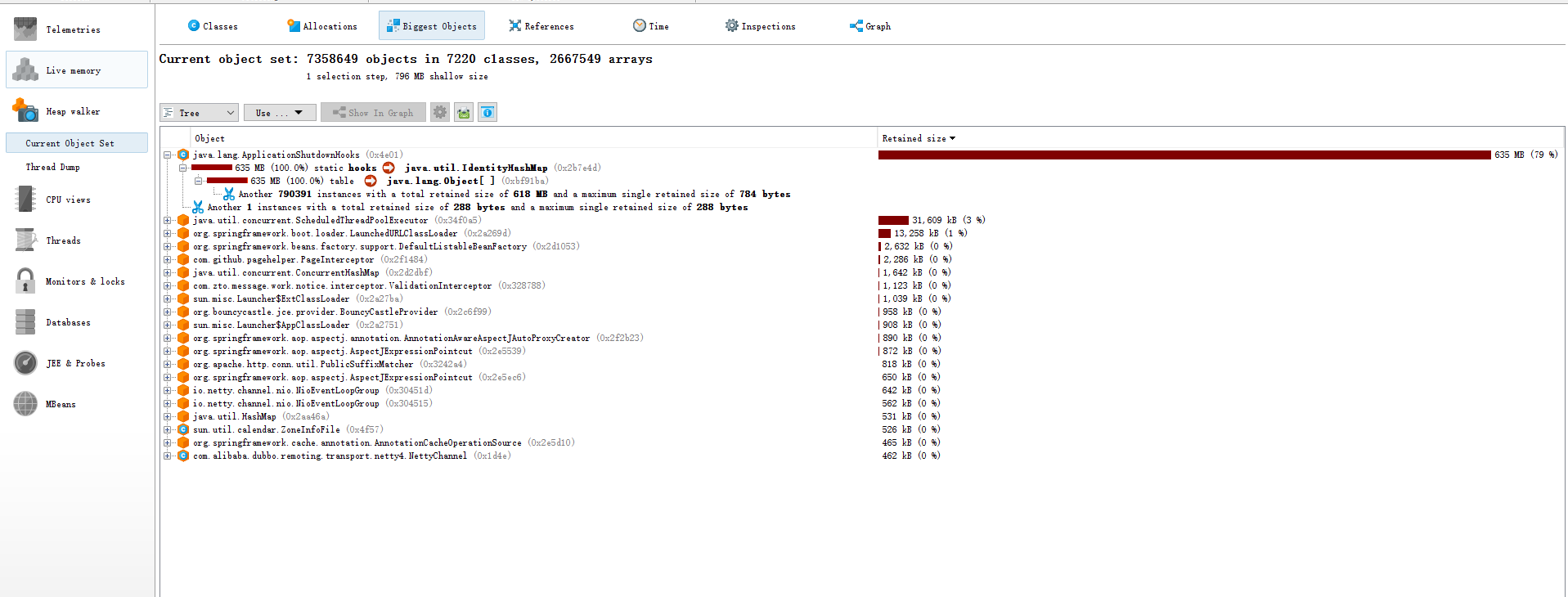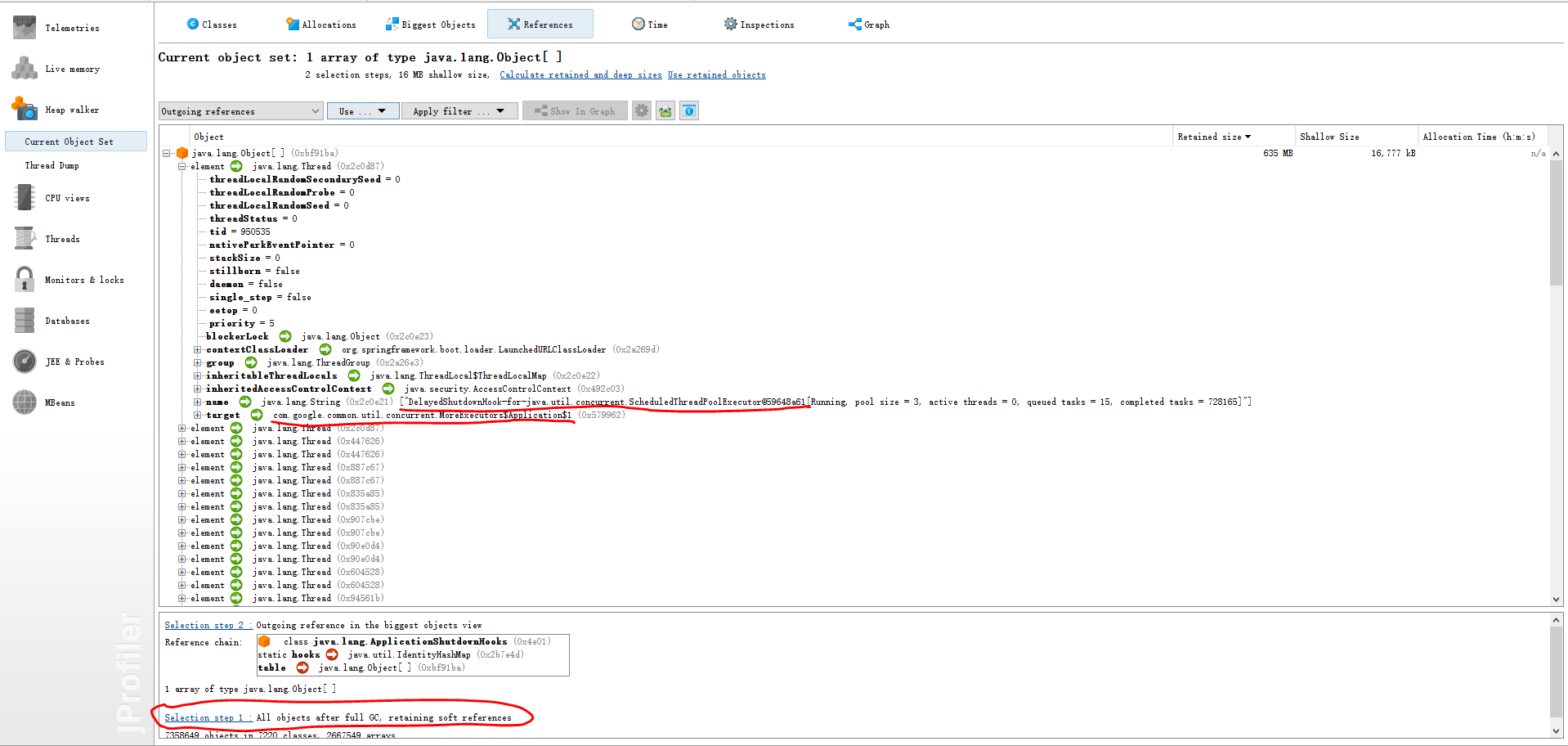记一次生产频繁发生FullGC问题
问题发现
早上过来,饭都没来的及吃,运维就给我发来信息,说是某个接口调用大量超时。因为最近这个接口调用量是翻倍了,所以我就去检查了下慢SQL,发现确实是有较多的慢SQL,所以我就缩减了查询的时间范围,但是效果并不好。
过了一会发现,这个服务fullGC是有问题的,太频繁了,这个应该是导致接口超时的根本问题,因为时间也是对的上的。
这个是最近三个小时fullGC的监控图:

这个是最近三天fullGC的监控图:

对比一下,就不难发现,fullGC数量是从3月15号晚上9点开始增加的,也是这个接口对外开放的时间。
解决思路
1、首先去服务器上面下载dump文件,分析是哪里造成了内存泄漏,频繁触发fullGC。首先找出服务器内java文件的PID,然后保存dump文件,我们公司java服务是固定端口号:1
使用top命令:

然后执行命令:jmap -dump:file=202303160924.dump,format=b 1 ,保存dump文件

2、根据dump文件,分析出堆内对象的分布情况
-
- 下载一个可以分析dump文件的工具,这里我下载是Jprofiler
- 查看大对象的分析,发现是java.lang.ApplicationShutdownHooks的hooks占用太大内存,并且得知改熟悉是一个Map

- 分析这个Map里面的元素引用关系,可以看到这个map里面存的都是线程对象,并且大部分都是一个名为java.util.concurrent.ScheduledThreadPoolExecutor@59648a61的线程池对象,到了这里就定位到问题代码了,是这次新加的接口里面有一个异步操作,用的guava并发包里面的一个超时等待功能的接口,具体思路就是启用一个定时任务线程池去定时去检查在规定时间内,是否返回结果。
??

3、看看我的业务代码是哪里出现了问题
//异步执行某个查询方法,并且在规定时间内返回查询结果
public <T> T asyncWithTimeout(ScheduledThreadPoolExecutor executor, Callable<T> callable,
long time, TimeUnit unit) {
try {
ListeningExecutorService listeningExecutorService = MoreExecutors.listeningDecorator(threadPoolExecutor);
ListenableFuture<T> future = listeningExecutorService.submit(callable);
//这里是创建一个定时任务线程,去定时检查是否在规定时间内查询完毕,应该就是这个去添加了钩子函数,进去看看
ScheduledExecutorService scheduledExecutorService = MoreExecutors.getExitingScheduledExecutorService(executor);
return Futures.withTimeout(future, time, unit, scheduledExecutorService).get(time, unit);
} catch (InterruptedException | ExecutionException | TimeoutException e) {
log.warn("异步方法执行失败,error:{}", e.getMessage());
}
return null;
}
//=======================guava并发包代码=======================
@Beta
@GwtIncompatible // TODO
public static ScheduledExecutorService getExitingScheduledExecutorService(
ScheduledThreadPoolExecutor executor) {
//每次都去创建一个新的对象
return new Application().getExitingScheduledExecutorService(executor);
}
final ScheduledExecutorService getExitingScheduledExecutorService(
ScheduledThreadPoolExecutor executor) {
return getExitingScheduledExecutorService(executor, 120, TimeUnit.SECONDS);
}
final ScheduledExecutorService getExitingScheduledExecutorService(
ScheduledThreadPoolExecutor executor, long terminationTimeout, TimeUnit timeUnit) {
useDaemonThreadFactory(executor);
ScheduledExecutorService service = Executors.unconfigurableScheduledExecutorService(executor);
//添加构造函数的地方,进去看看
addDelayedShutdownHook(executor, terminationTimeout, timeUnit);
return service;
}
final void addDelayedShutdownHook(
final ExecutorService service, final long terminationTimeout, final TimeUnit timeUnit) {
checkNotNull(service);
checkNotNull(timeUnit);
//继续点进去
addShutdownHook(
MoreExecutors.newThread(
//线程名字对上了,就在对象引用的截图里面出现过
"DelayedShutdownHook-for-" + service,
new Runnable() {
@Override
public void run() {
try {
// We'd like to log progress and failures that may arise in the
// following code, but unfortunately the behavior of logging
// is undefined in shutdown hooks.
// This is because the logging code installs a shutdown hook of its
// own. See Cleaner class inside {@link LogManager}.
service.shutdown();
service.awaitTermination(terminationTimeout, timeUnit);
} catch (InterruptedException ignored) {
// We're shutting down anyway, so just ignore.
}
}
}));
}
@VisibleForTesting
void addShutdownHook(Thread hook) {
Runtime.getRuntime().addShutdownHook(hook);
}
//=======================guava并发包代码=======================
public void addShutdownHook(Thread hook) {
SecurityManager sm = System.getSecurityManager();
if (sm != null) {
sm.checkPermission(new RuntimePermission("shutdownHooks"));
}
//定位到问题了,就是这里添加的钩子函数
ApplicationShutdownHooks.add(hook);
}
static synchronized void add(Thread hook) {
if(hooks == null)
throw new IllegalStateException("Shutdown in progress");
if (hook.isAlive())
throw new IllegalArgumentException("Hook already running");
if (hooks.containsKey(hook))
throw new IllegalArgumentException("Hook previously registered");
//存在到 hooks 这个map对象里面,就是这个大对象
hooks.put(hook, hook);
}问题解决
经过上面问题的排查,造成hooks大对象的原因找到了,就是每次调用接口的时候,都会往hooks里面put一个对象。
所以,解决办法很简单,就是不用每次都去生成一个ScheduledExecutorService对象,类初始化的时候创建一次就行了
改造后的代码如下:
private ListeningExecutorService listeningExecutorService;
private ScheduledExecutorService scheduledExecutorService;
public static AsyncUtils getInstance() {
return ThreadHolder.INSTANCE.getAsyncWithCallback();
}
@SuppressWarnings("UnstableApiUsage")
private AsyncUtils() {
listeningExecutorService = MoreExecutors.listeningDecorator(ThreadPoolConstant.THREAD_POOL_EXECUTOR);
scheduledExecutorService = MoreExecutors.getExitingScheduledExecutorService(ThreadPoolConstant.SCHEDULED_THREAD_POOL_EXECUTOR);
}
@SuppressWarnings("UnstableApiUsage")
public <T> T asyncWithTimeout(Callable<T> callable,
long time, TimeUnit unit) {
try {
ListenableFuture<T> future = listeningExecutorService.submit(callable);
return Futures.withTimeout(future, time, unit, scheduledExecutorService).get(time, unit);
} catch (InterruptedException | ExecutionException | TimeoutException e) {
log.warn("异步方法执行失败,error:{}", e.getMessage());
}
return null;
}
private enum ThreadHolder {
/**
* 线程持有类 INSTANCE
*/
INSTANCE;
private final AsyncUtils asyncUtils;
ThreadHolder() {
asyncUtils = new AsyncUtils();
}
public AsyncUtils getAsyncWithCallback() {
return asyncUtils;
}
}